Native
Platynota flavedana Clemens (Tortricidae: Tortricinae: Sparganothini)
Synonyms: concursana (Teras), iridana (Platynota), laterana (Teras), tinctana (Teras)
FWL: 5.0-6.5 mm (males); 6.0-8.5 mm (females)
Platynota flavedana is sexually dimorphic. The male forewing is dark purplish brown basally and yellowish to orangish brown apically. The female forewing is brown to orangish brown with dark-brown to purplish-brown markings. Hindwings of both sexes are brown to orangish brown; males tend to exhibit more orange than females. Males have a long forewing costal foldforewing costal fold:
a flap or fold at the base of the forewing that contains specialized sex scales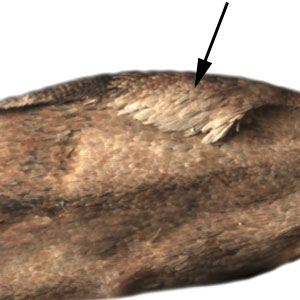 that extends to mid-costa.
that extends to mid-costa.
Male genitalia are characterized by a slender uncusuncus:
a sclerotized process which is fused to the posterodorsal margin of tergum IX which is broader at the base; elongate, well-developed sociisocii:
which is broader at the base; elongate, well-developed sociisocii:
a pair of lightly sclerotized setose lobes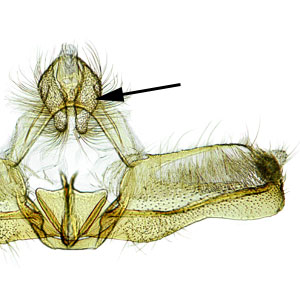 ; and rounded, elliptical valvaevalvae:
; and rounded, elliptical valvaevalvae:
plural of "valva" with a small triangular projection on the ventralventral:
with a small triangular projection on the ventralventral:
lower, to the bottom, on the under side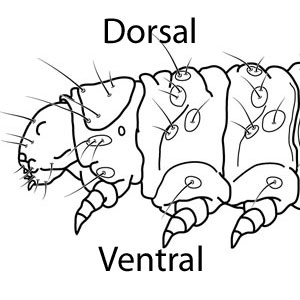 margin. Female genitalia are characterized by a bowl-like sterigmasterigma:
margin. Female genitalia are characterized by a bowl-like sterigmasterigma:
the sclerotized region surrounding the female ostium bursae  ; and signumsignum:
; and signumsignum:
a sclerotized projection or patch on the interior of the corpus bursae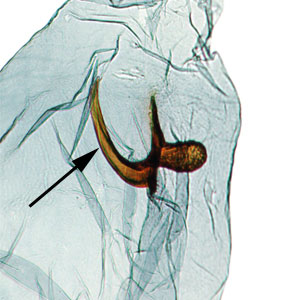 present as a band-like sclerite at the base of the corpus bursaecorpus bursae:
present as a band-like sclerite at the base of the corpus bursaecorpus bursae:
a dilated membranous sac at the anterior end of the bursa copulatrix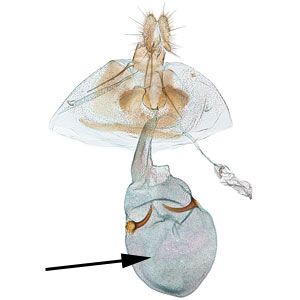 .
.
The following account is summarized from MacKay (1962a) and Powell & Brown (2012).
Mature larva approximately 13-21 mm in length; width of head 1.3-1.4 mm; head, prothoracic shieldprothoracic shield:
a sclerotized plate on the dorsal surface of the prothorax 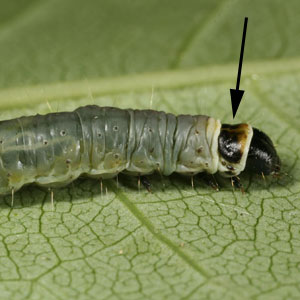 brownish yellow; body pale green; anal fork present with 5-8 teeth.
brownish yellow; body pale green; anal fork present with 5-8 teeth.
Detailed figures and descriptions of larval chaetotaxychaetotaxy:
the arrangement of setae (in reference to Lepidoptera larvae), often depicted on a "setal map"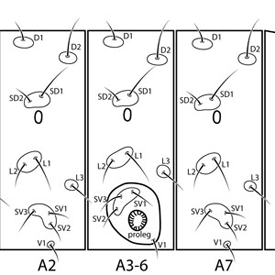 are available in MacKay (1962a) and Powell & Brown (2012).
are available in MacKay (1962a) and Powell & Brown (2012).
Adults may appear similar to other species of Platynota, especially P. rostrana and P. labiosana. From P. rostrana, P. flavedana can can be distinguished by the scaling on the head: with a complex “hood” in P. rostrana compared to a simple one in P. flavedana. Platynota flavedana can be distinguished from P. labiosana by forewing color, pattern, and distribution. A genitalic dissection can be used to confirm identity.
Larvae appear similar to those of Sparganothis sulfureana, and the two species are often found in similar habitats in the eastern United States. MacKay (1962a) stated that larvae of Platynota could be separated from similar species of Sparganothis by the small dorsaldorsal:
upper, to the top, on the back  pinacula on A1-8, which are slightly elongate and cream colored in living individuals.
pinacula on A1-8, which are slightly elongate and cream colored in living individuals.
The following account is summarized from Wilde & Semel (1966) and Powell & Brown (2012).
Platynota flavedana completes two annual generations over much of its range; a partial third generation may be present in the South. Adults are present May-June and July-September.
Females lay eggs in masses that contain approximately 50 individual eggs on the upper surface of leaves. Larvae feed within a shelter constructed of tied or folded leaves. Larvae may cause economic damage by feeding on blossoms or fruit, and will often web leaves together with blossoms and immature fruit. Mid-instar larvae of the last generation overwinter and resume feeding the following spring. Pupation occurs in webbed leaves.
Larvae of P. flavedana have been reported as pests of strawberry, peach, and rose. Other important hosts include cotton and citrus.
| Host plant | Host plant family | Reference(s) |
| Acer sp. | Aceraceae | Fernald 1882aFernald 1882a: Fernald, C. H. 1882a. A synonymical catalogue of the described Tortricidae of North America, north of Mexico. Transactions of the American Entomological Society. 10: 1-64.; Meyrick MS 1938Meyrick MS 1938: Meyrick MS 1938. Unpublished manuscript by E. Meyrick at BMNH, data captured by Gaeden Robinson. |
| Amaranthus sp. | Amaranthaceae | Powell & Brown 2012 |
| Cicuta maculata | Apiaceae | Powell & Brown 2012 |
| Asclepias sp. | Asclepiadaceae | Powell & Brown 2012 |
| Aster sp. | Asteraceae | Powell & Brown 2012 |
| Eupatorium compositifolium | Asteraceae | Bottimer 1926Bottimer 1926: Bottimer, L.J. 1926. Notes on some Lepidoptera from eastern Texas. Journal of Agricultural Research. 33: 797-819. |
| Eupatorium sp. | Asteraceae | Meyrick MS 1938Meyrick MS 1938: Meyrick MS 1938. Unpublished manuscript by E. Meyrick at BMNH, data captured by Gaeden Robinson.; MacKay 1962aMacKay 1962a: MacKay, M. R. 1962a. Larvae of the North American Tortricinae (Lepidoptera: Tortricidae). Canadian Entomologist, Supplement 28: 1-182. |
| Helianthus sp. | Asteraceae | Bottimer 1926Bottimer 1926: Bottimer, L.J. 1926. Notes on some Lepidoptera from eastern Texas. Journal of Agricultural Research. 33: 797-819. |
| Parthenium integrifolium | Asteraceae | Powell & Brown 2012 |
| Dianthus caryophyllus | Caryophyllaceae | LACM IndexLACM Index: LACM Index. Records from the card file at the Los Angeles County Museum of Natural History, Los Angeles, California; transcribed by Gaeden Robinson (BMNH). |
| Helianthemum sp. | Cistaceae | Meyrick MS 1938Meyrick MS 1938: Meyrick MS 1938. Unpublished manuscript by E. Meyrick at BMNH, data captured by Gaeden Robinson. |
| Hypericum perforatum | Clusiaceae | Sandberg & Passoa 1989 |
| Rhododendron sp. | Ericaceae | MacKay 1962aMacKay 1962a: MacKay, M. R. 1962a. Larvae of the North American Tortricinae (Lepidoptera: Tortricidae). Canadian Entomologist, Supplement 28: 1-182. |
| Vaccinium sp. | Ericaceae | Powell & Brown 2012 |
| Arachis hypogea | Fabaceae | Powell & Brown 2012 |
| Baptisia australis | Fabaceae | Powell & Brown 2012 |
| Medicago sativa | Fabaceae | Powell & Brown 2012 |
| Melilotus alba | Fabaceae | Powell & Brown 2012 |
| Sesbania vesicaria | Fabaceae | Powell & Brown 2012 |
| Trifolium sp. | Fabaceae | Host plant table (embedded)
View full screen host table here DistributionPlatynota flavedana is widely distributed in the eastern United States. Records exist from New Hampshire and South Dakota south to eastern Texas and Florida. Additional records exist for northern Mexico, Costacosta: LinksAdditional photos and a distribution map of this species in North America are available at Moth Photographers Group. |